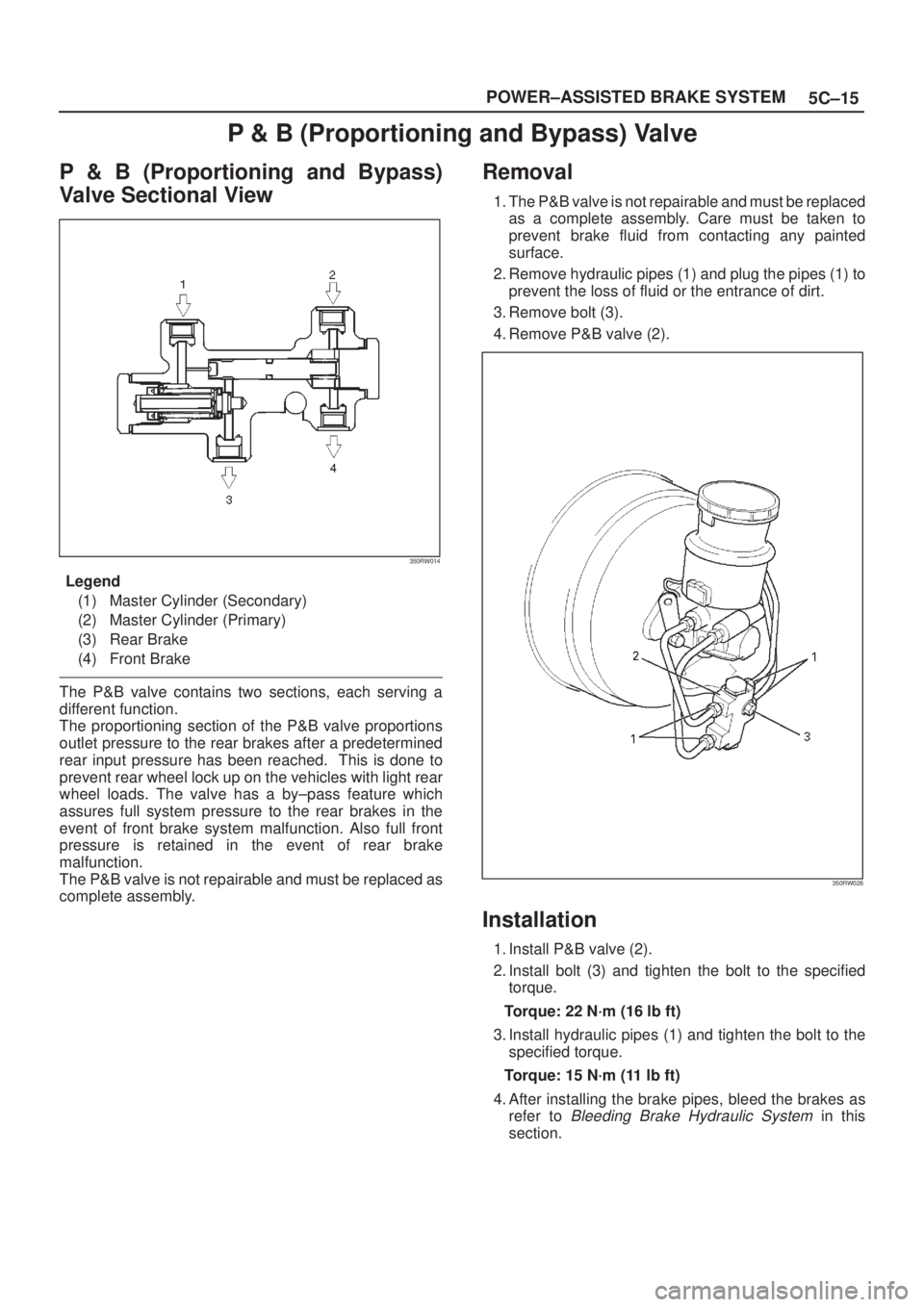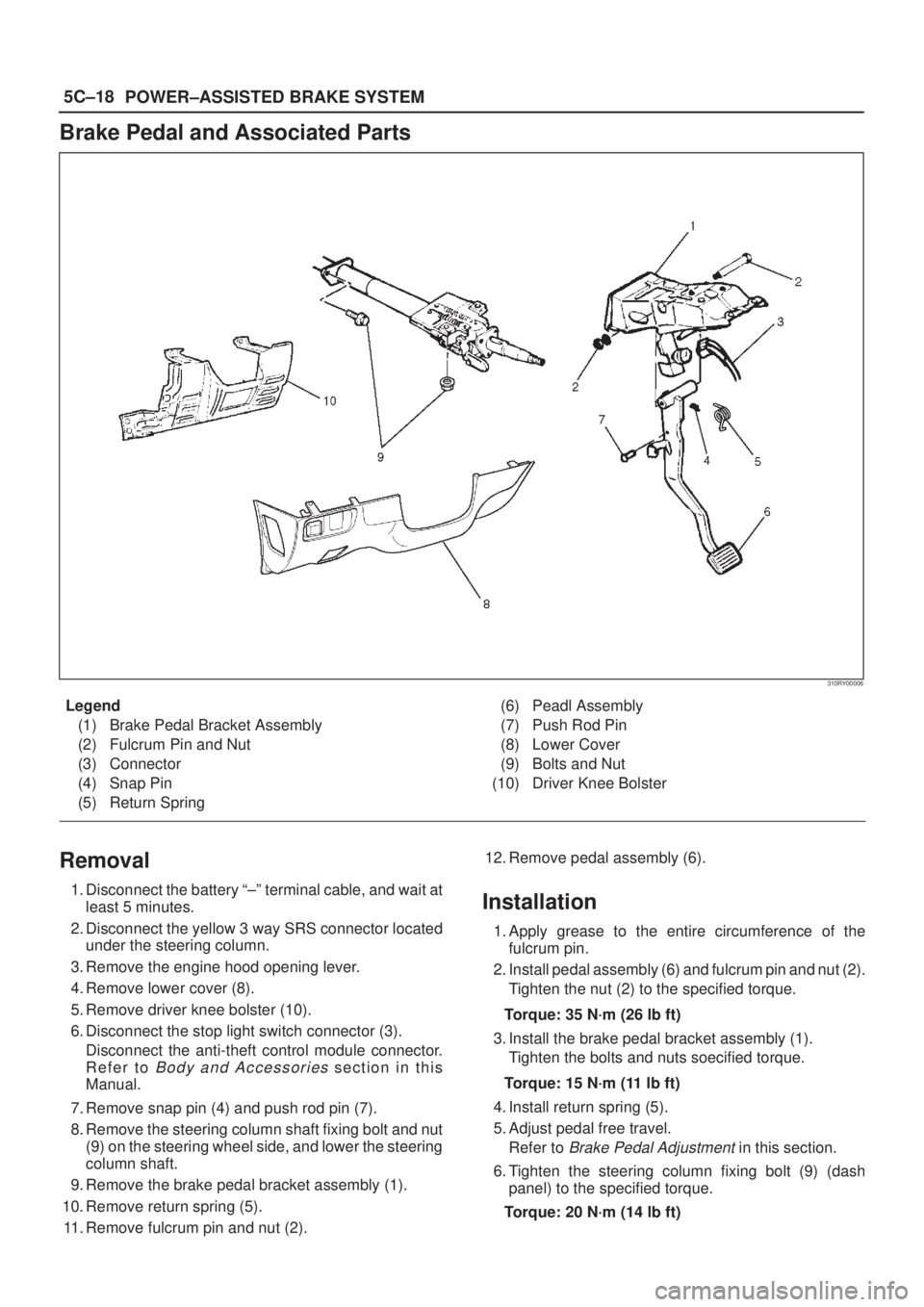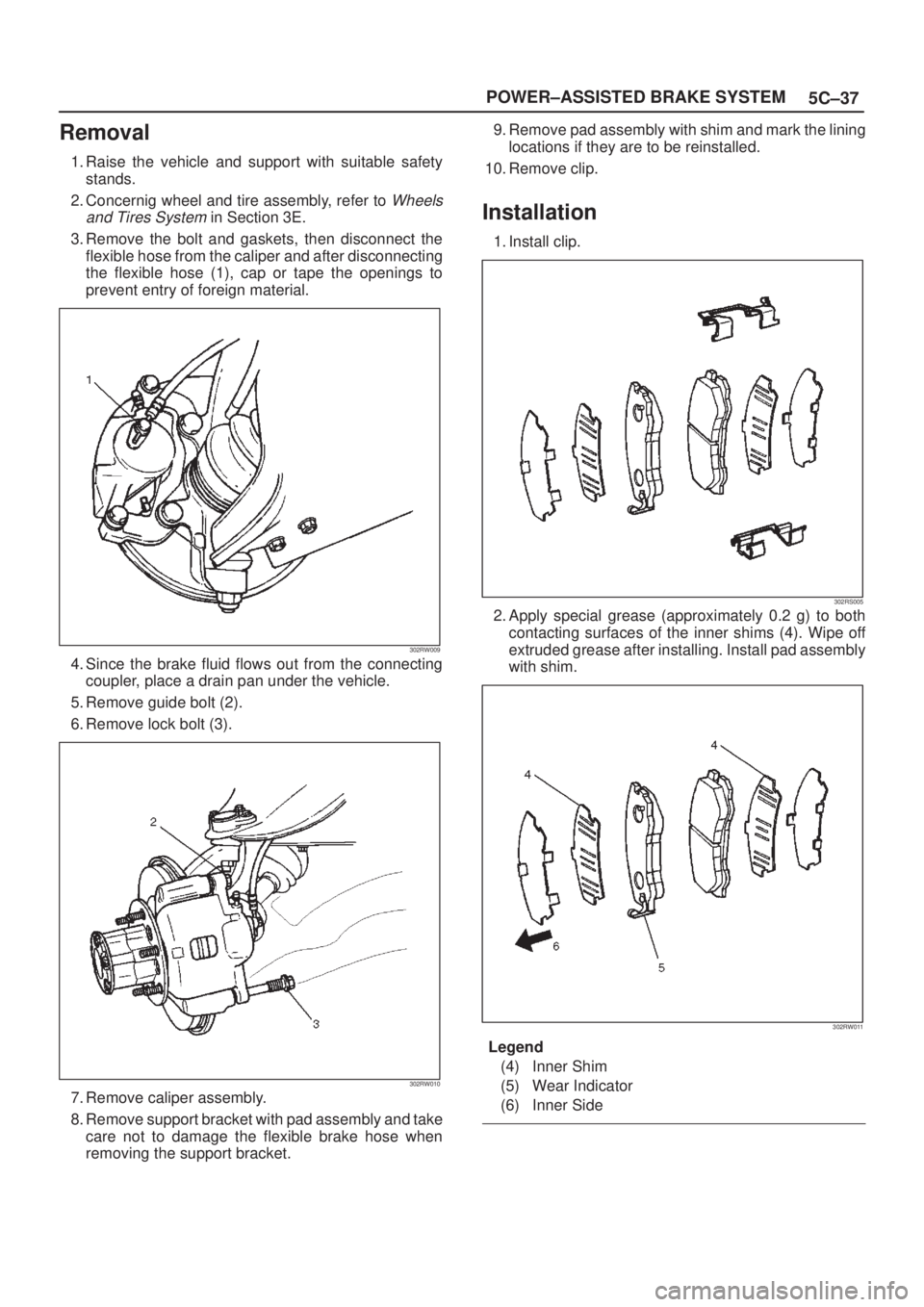Page 694 of 2100
5C±14
POWER±ASSISTED BRAKE SYSTEM
Brake Pipe
Removal
1. Raise the vehicle and support it with suitable safety
stands.
2. Remove wheel and tire assembly as necessary.
3. Clean dirt, grease, and other foreign material off the
pipe fittings at both ends.
4. Remove brake pipe (1).
330RW011
5. Remove plastic clip (2).
330RW002
Installation
To install, follow the removal steps in the reverse order,
noting the following points.
1. Tighten the brake pipes to the specified torque.
Master cylinder and Proportioning and Bypass
valve sides
Torque: 15 N´m (11 lb ft)
Others
Torque: 16 N´m (12 lb ft)
After installing the brake pipes, bleed the brakes as
described in this section.
Page 695 of 2100

5C±15 POWER±ASSISTED BRAKE SYSTEM
P & B (Proportioning and Bypass) Valve
P & B (Proportioning and Bypass)
Valve Sectional View
350RW014
Legend
(1) Master Cylinder (Secondary)
(2) Master Cylinder (Primary)
(3) Rear Brake
(4) Front Brake
The P&B valve contains two sections, each serving a
different function.
The proportioning section of the P&B valve proportions
outlet pressure to the rear brakes after a predetermined
rear input pressure has been reached. This is done to
prevent rear wheel lock up on the vehicles with light rear
wheel loads. The valve has a by±pass feature which
assures full system pressure to the rear brakes in the
event of front brake system malfunction. Also full front
pressure is retained in the event of rear brake
malfunction.
The P&B valve is not repairable and must be replaced as
complete assembly.
Removal
1. The P&B valve is not repairable and must be replaced
as a complete assembly. Care must be taken to
prevent brake fluid from contacting any painted
surface.
2. Remove hydraulic pipes (1) and plug the pipes (1) to
prevent the loss of fluid or the entrance of dirt.
3. Remove bolt (3).
4. Remove P&B valve (2).
350RW026
Installation
1. Install P&B valve (2).
2. Install bolt (3) and tighten the bolt to the specified
torque.
Torque: 22 N´m (16 lb ft)
3. Install hydraulic pipes (1) and tighten the bolt to the
specified torque.
Torque: 15 N´m (11 lb ft)
4. After installing the brake pipes, bleed the brakes as
refer to
Bleeding Brake Hydraulic System in this
section.
Page 698 of 2100

5C±18
POWER±ASSISTED BRAKE SYSTEM
Brake Pedal and Associated Parts
310RY00006
Legend
(1) Brake Pedal Bracket Assembly
(2) Fulcrum Pin and Nut
(3) Connector
(4) Snap Pin
(5) Return Spring(6) Peadl Assembly
(7) Push Rod Pin
(8) Lower Cover
(9) Bolts and Nut
(10) Driver Knee Bolster
Removal
1. Disconnect the battery ª±º terminal cable, and wait at
least 5 minutes.
2. Disconnect the yellow 3 way SRS connector located
under the steering column.
3. Remove the engine hood opening lever.
4. Remove lower cover (8).
5. Remove driver knee bolster (10).
6. Disconnect the stop light switch connector (3).
Disconnect the anti-theft control module connector.
Refer to
Body and Accessories section in this
Manual.
7. Remove snap pin (4) and push rod pin (7).
8. Remove the steering column shaft fixing bolt and nut
(9) on the steering wheel side, and lower the steering
column shaft.
9. Remove the brake pedal bracket assembly (1).
10. Remove return spring (5).
11. Remove fulcrum pin and nut (2).12. Remove pedal assembly (6).
Installation
1. Apply grease to the entire circumference of the
fulcrum pin.
2. Install pedal assembly (6) and fulcrum pin and nut (2).
Tighten the nut (2) to the specified torque.
Torque: 35 N´m (26 lb ft)
3. Install the brake pedal bracket assembly (1).
Tighten the bolts and nuts soecified torque.
Torque: 15 N´m (11 lb ft)
4. Install return spring (5).
5. Adjust pedal free travel.
Refer to
Brake Pedal Adjustment in this section.
6. Tighten the steering column fixing bolt (9) (dash
panel) to the specified torque.
Torque: 20 N´m (14 lb ft)
Page 713 of 2100
5C±33 POWER±ASSISTED BRAKE SYSTEM
Removal
NOTE: If a squealing noise occurs from the front brake
while driving, check the pad wear indicator plate. If the
indicator plate contacts the rotor, the disc pad assembly
should be replaced.
�Draw out two±thirds of the brake fluid from the
reservoir.
�Raise the vehicle and support it with suitable safety
stands.
1. Remove wheel and tire assembly, refer to
Wheels
and Tires System
in Section 3E.
2. Remove lock bolt (1).
302RW004
3. Rotate caliper assembly and support the caliper
assembly so that the brake hose is not stretched or
damaged.
4. Remove pad assembly with shim.
5. Remove Clip.
Installation
1. Install clip.
302RS005
2. Apply special grease (approximately 0.2 g) to both
contacting surfaces of the inner shims (2). Wipe off
extruded grease after installing. Install pad assembly
with shim.
302RW005
Legend
(2) Inner Shim
(3) Wear Indicator
(4) Inner Side
Page 714 of 2100
5C±34
POWER±ASSISTED BRAKE SYSTEM
302RW006
3. Carefyully use adjustable pliers to bottom the piston
into the caliper bore. Do not pull or twist the flexible
hose or damage will occur.
Install caliper assembly.
Set caliper assembly in place.
302RS008
4. Install lock bolt (5) and tighten the bolt to the specified
torque.
Torque: 74 N´m (54 lb ft)
302RW018
5. Install wheel and tire assembly, refer to Wheels and
Tires System
in Section 3E.
6. Pump the brake pedal several times to make sure that
the pedal is firm. Check the brake fluid level in the
reservoir after pumping the brakes.
Page 715 of 2100

5C±35 POWER±ASSISTED BRAKE SYSTEM
Front Disc Brake Rotor
Inspection
In the manufacturing of the brake rotor, all the tolerances
regarding surface finish, parallelism and lateral runout are
held very closely. Maintaining these tolerances provides
the surface necessary to assure smooth brake operation.
Lateral Runout
Lateral runout is the movement of the rotor from side to
side as it rotates on the spindle. This could also be
referred to as ªrotor wobbleº.
This movement causes the piston to be knocked back into
its bore. This results in additional pedal travel and a
vibration during braking.
Checking Lateral Runout
1. Adjust the wheel bearing correctly, refer to Differential
in Section 4A1.
2. Attach the dial indicator accordingly so that the stem
contacts the rotor surface to approximately 29mm
(1.14 in) from the rotor edge.
3. Rotate the rotor one complete turn and inspect for
signs of lateral runout. Lateral runout should not
exceed 0.13 mm (0.005 in).
Maximum runout: 0.13 mm (0.005 in)
411RS019
Parallelism
Parallelism is the measurement of thickness of the rotor
at four or more points around the circumference of the
rotor. All measurement must be made at 29 mm (1.14 in)
from the edge of the rotor.
The rotor thickness must not vary more than 0.010 mm
(0.0004 in) from point to point.
Maximum runout: 0.010 mm (0.0004 in)
411RS018
Replacing Brake Rotors
When installing new brake rotors, do not refinish the
surfaces. These parts are at the correct level of surface
finish.
Refinishing Brake Rotors
Accurate control of the rotor tolerances is necessary for
proper performance of the disc brakes. Machining of the
rotor should be done only with precision equipment. All
brake rotors have a minimum thickness dimension cast
into them. This dimension is the minimum wear
dimension and not a refinish dimension. The minimum
wear dimension is 24.60 mm (0.969 in). The minimum
refinish dimension is 24.97 mm (0.983 in).
When refinishing rotors, always use sharp cutting tools or
bits. Dull or worn tools leave a poor surface finish which
will affect initial braking performance. Vibration
dampening attachments should always be used when
refinishing braking surfaces. These attachments
eliminate tool chatter and will result in better surface
finish.
After refinishing, replace any rotor that does not meet the
minimum thickness of 24.97 mm (0.983 in). Do not use a
brake rotor that exceeds the manufacturers
specifications.
Minimum wear dimension: 24.60 mm (0.969 in)
Refinish dimension: 24.97 mm (0.983 in)
Page 717 of 2100

5C±37 POWER±ASSISTED BRAKE SYSTEM
Removal
1. Raise the vehicle and support with suitable safety
stands.
2. Concernig wheel and tire assembly, refer to
Wheels
and Tires System
in Section 3E.
3. Remove the bolt and gaskets, then disconnect the
flexible hose from the caliper and after disconnecting
the flexible hose (1), cap or tape the openings to
prevent entry of foreign material.
302RW009
4. Since the brake fluid flows out from the connecting
coupler, place a drain pan under the vehicle.
5. Remove guide bolt (2).
6. Remove lock bolt (3).
302RW010
7. Remove caliper assembly.
8. Remove support bracket with pad assembly and take
care not to damage the flexible brake hose when
removing the support bracket.9. Remove pad assembly with shim and mark the lining
locations if they are to be reinstalled.
10. Remove clip.
Installation
1. Install clip.
302RS005
2. Apply special grease (approximately 0.2 g) to both
contacting surfaces of the inner shims (4). Wipe off
extruded grease after installing. Install pad assembly
with shim.
302RW011
Legend
(4) Inner Shim
(5) Wear Indicator
(6) Inner Side
Page 718 of 2100
5C±38
POWER±ASSISTED BRAKE SYSTEM
3. Install support bracket and tighten the bolt (7) to the
specified torque.
Torque: 155 N´m (115 lb ft)
302RW012
4. Install caliper assembly.
5. Install lock bolt (9) and guide bolt (8) and tighten the
bolt to the specified torque.
Torque: 74 N´m (54 lb ft)
302RW013
6. Install brake flexible hose, always use new gaskets
and be sure to put the hooked edge of the flexible
hose end into the anti±rotation cavity then tighten the
I±bolt (10) to the specified torque.
Torque: 35 N´m (26 lb ft)
302RW014
7. Install wheel and tire assembly, refer to Wheels and
Tires System
in Section 3E.
8. Bleed brakes. Refer to
Hydraulic Brakes in this
section.